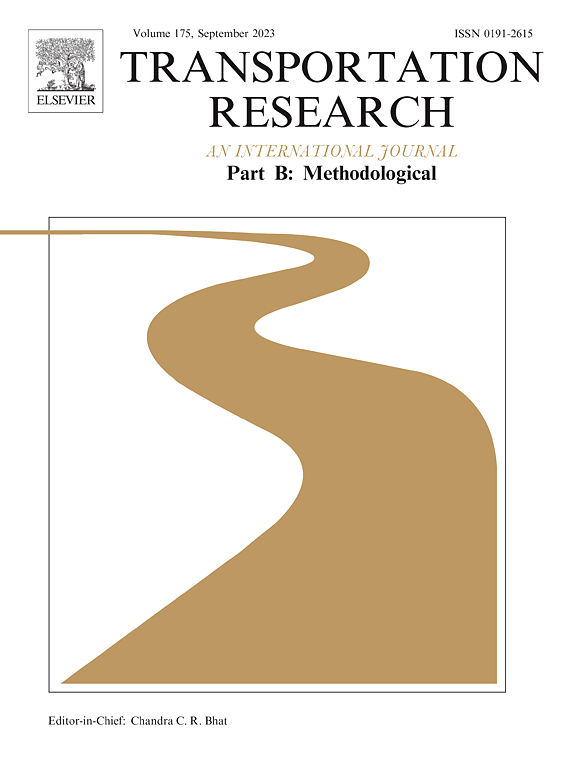Choice-driven bilevel optimization for multiclass traffic congestion management via eco-routing incentives
IF 6.3
1区 工程技术
Q1 ECONOMICS
引用次数: 0
Abstract
This study contributes to sustainable transportation modeling by proposing a user-centric approach to incentivize eco-routing travel behavior. We propose a novel reward credit scheme to provide path-based commuter incentives with the goal of reducing emissions and the total system travel time. The scheme takes into account multiple classes of commuters in the network that differ by their value of time and their vehicle energy type. Users subscribing to the scheme may earn monetary reward credits which act as incentives to promote sustainable mobility. Two types of reward credits are considered: subscription- and path-based credits. A discrete choice model is embedded within a traffic assignment model to capture the endogenous impact of commuters’ scheme adoption onto network congestion effects. We introduce a bilevel optimization formulation to determine optimal non-additive, path-based reward credits and subscription-based reward credits within a predefined budget under traffic equilibrium conditions. In this formulation, the follower problem is a parameterized multi-class user equilibrium traffic assignment problem with non-additive path costs and incorporates a logit choice model for scheme adoption. The leader represent the network regulator whose goal is to maximize social welfare by minimizing the total system travel time and total emissions. We develop a single-level Karush–Kuhn–Tucker reformulation and propose a customized branch-and-bound algorithm to solve this bilevel optimization problem. Numerical experiments demonstrate the potential of eco-routing incentives to promote sustainable urban mobility and highlight the benefits of combining subscription- and path-based reward credits for traffic congestion management.
基于生态路径激励的多级交通拥堵管理的选择驱动双层优化
本研究通过提出以用户为中心的方法来激励生态路线出行行为,为可持续交通建模做出了贡献。我们提出了一种新的奖励积分方案,以减少二氧化碳排放和系统总旅行时间为目标,提供基于路径的通勤激励。该方案考虑了网络中不同类型的通勤者,他们的时间价值和车辆能量类型不同。订阅该计划的用户可获得货币奖励积分,作为促进可持续交通的激励措施。我们考虑了两种类型的奖励积分:订阅积分和基于路径的积分。在交通分配模型中嵌入离散选择模型,以捕捉通勤者方案采用对网络拥塞效应的内生影响。我们引入了一个双层优化公式,以确定最优的非加性,基于路径的奖励积分和基于订阅的奖励积分在预定义的预算在交通平衡条件下。在该公式中,follower问题是一个具有非加性路径成本的参数化多类用户均衡流量分配问题,并引入了一个logit选择模型用于方案的采用。领导者代表网络监管者,其目标是通过最小化系统总运行时间和总二氧化碳排放量来最大化社会福利。我们发展了一个单层次的Karush-Kuhn-Tucker重构,并提出了一个定制的分支定界算法来解决这个双层优化问题。数值实验证明了生态路线激励在促进可持续城市交通方面的潜力,并强调了将订阅和基于路径的奖励积分结合起来用于交通拥堵管理的好处。
本文章由计算机程序翻译,如有差异,请以英文原文为准。
求助全文
约1分钟内获得全文
求助全文
来源期刊
CiteScore
12.40
自引率
8.80%
发文量
143
审稿时长
14.1 weeks
期刊介绍:
Transportation Research: Part B publishes papers on all methodological aspects of the subject, particularly those that require mathematical analysis. The general theme of the journal is the development and solution of problems that are adequately motivated to deal with important aspects of the design and/or analysis of transportation systems. Areas covered include: traffic flow; design and analysis of transportation networks; control and scheduling; optimization; queuing theory; logistics; supply chains; development and application of statistical, econometric and mathematical models to address transportation problems; cost models; pricing and/or investment; traveler or shipper behavior; cost-benefit methodologies.

 求助内容:
求助内容: 应助结果提醒方式:
应助结果提醒方式:


